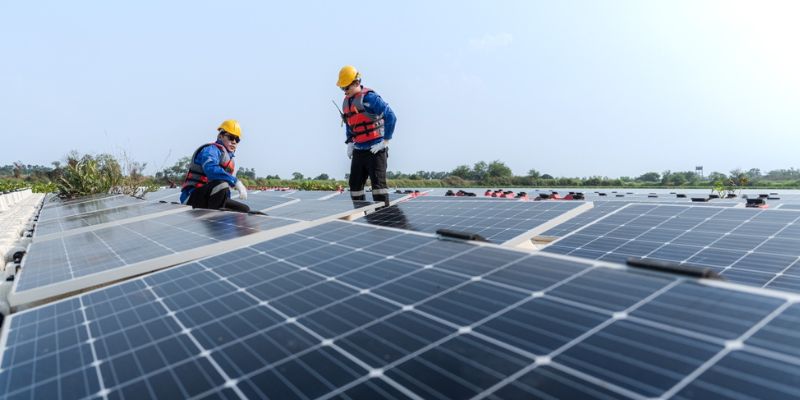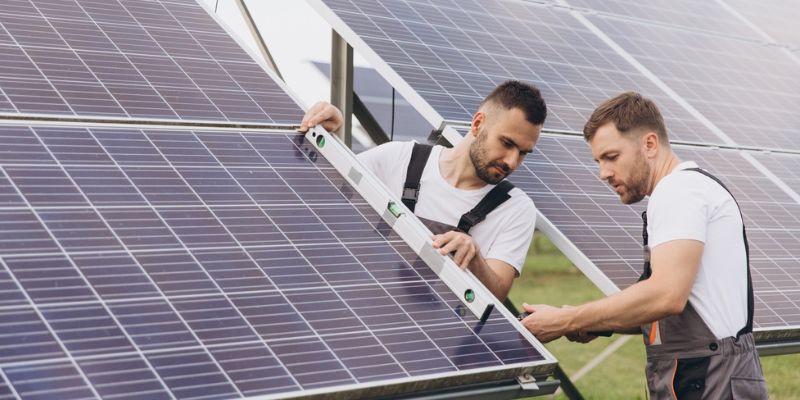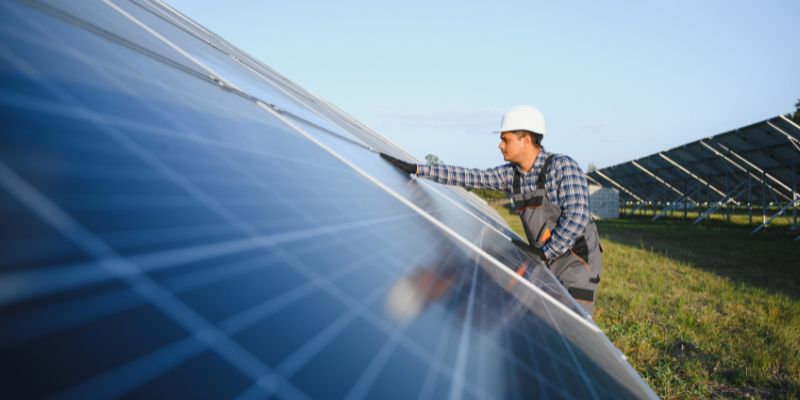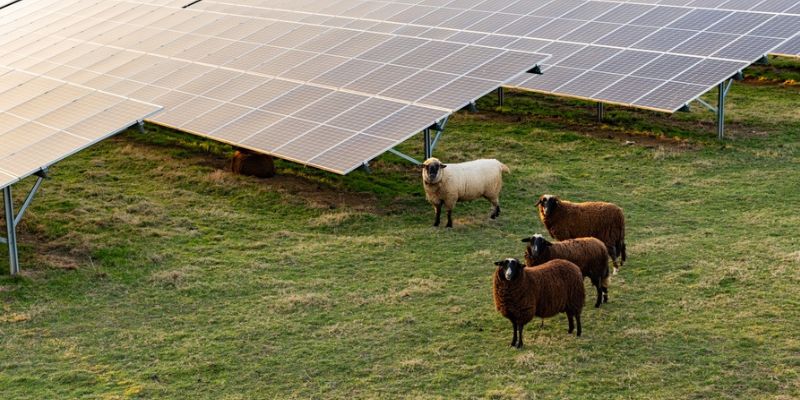Loans for farmers to install solar panels are helping agricultural businesses slash their utility bills and keep more money in their pockets.
This blog explores why solar power in agriculture is becoming a game changer, how solar panel loans work so you can apply to them, and how Janus Ag Finance’s solar power financing can help your farm save thousands.
Rising Energy Costs on Farms and the Solar Solution
Energy is a significant expense for farms. Modern farming relies heavily on electricity from irrigation pumps and dairy milking machines to refrigeration and lighting. In recent years, utility rates have climbed sharply; for example, California saw farm electricity rates jump over 40% in just three years. These rising costs cut directly into farm profits.
Farmers increasingly turn to solar power as a stable, cost-effective alternative when faced with high energy bills. Solar panels let farms generate electricity from the sun, insulating them from rate hikes. When the sun is shining, a well-sized solar array can often meet 100% of a farm’s energy needs or even produce surplus power that can be sold back to the grid for credits.
Solar Power in Agriculture: Key Benefits and Savings

1. Dramatic Electricity Cost Savings
The primary motivation for most farms to go solar is the potential for huge savings on electricity bills. Farms that install solar have reported cutting their energy costs by 50% to 70% on average. Studies show that a modest 10-kilowatt (kW) solar system can save a farm roughly $1,800 per year in electricity costs.
Larger installations yield even bigger savings. One dairy farm in Pennsylvania slashed its electric bill from about $2,500 a month to just $75 after adding solar panels. Thousands of dollars saved every year can be reinvested into the farm.

2. Protection from Rising Energy Prices
Once your panels are in place, much of your energy is produced for free. This shields your farm from future utility rate hikes. With solar, you effectively lock in a lower cost of power for 25+ years (the typical lifespan of panels). This long-term price stability is incredibly valuable for planning and budgeting in a farming operation.

3. Generous Incentives and Tax Credits
Governments are encouraging renewable energy in agriculture. Farmers may qualify for federal tax credits (around 30% of the system cost can be claimed back as a credit) and local rebates for installing solar.
Combined with loan guarantees for a portion of the remaining cost, these programs make solar far more affordable. Essentially, incentives significantly reduce the payback period on a solar investment; many farm solar projects now pay for themselves in as little as 5–7 years, after which the energy savings are pure profit.

4. Low Maintenance, High Reliability
Solar panels for farmers have no moving parts, which means maintenance is minimal. Once installed, a solar array quietly generates power whenever the sun shines. Occasional cleaning and annual check-ups are usually all that’s needed.

5. Boosted Farm Value and Resilience
Installing solar can increase your property’s value and appeal. A farm equipped with its renewable energy source may be appraised higher, and if you ever sell the farm, buyers will appreciate the lower operating costs. Moreover, solar power can be paired with battery storage for critical backup power, which keeps the lights on and the barn running during grid outages or emergencies.

6. Environmental Sustainability
Beyond dollars and cents, going solar reduces the farm’s carbon footprint and pollution. Many farmers take pride in stewarding their land for future generations. Solar energy is clean and renewable, aligning with conservation values. Adopting solar can also improve a farm’s public image; today’s consumers and business partners increasingly value sustainability.

Steps to Get Started with a Solar Panel Loan
- Assess Your Energy Needs: Look at your farm’s electricity usage. How many kilowatt-hours (kWh) do you use per month on average? Identify the major energy hogs (irrigation pumps, dairy barn equipment, cold storage, etc.). This gives you a target for how big a solar system you might need. Many solar installers offer free evaluations to estimate what size array would power your operations.
- Explore Solar Installers and Get Quotes: Reach out to reputable solar providers with agricultural project experience. Get a few quotes for a solar installation on your farm (whether roof-mounted on a barn or ground-mounted in a field). Compare each quote’s costs, projected energy output, and estimated savings. A good installer will also help quantify incentives like the 30% federal tax credit and state programs.
- Research Incentives and Grants: Check what grants or rebates you might qualify for. As mentioned, the USDA’s REAP grant can cover up to half the cost for many farm renewable energy projects, which is worth looking into. Some states and local utilities have additional incentives. Reducing the project cost with “free money” puts you in an even better position when financing the rest.
- Choose a Financing Partner: Now, figure out how to finance the portion of the project not covered by your savings or grants. This is where Janus Ag Finance’s solar panel loans for farmers come in. Contact a Janus Ag Finance loan specialist about financing options. They will discuss loan terms and monthly payment estimates and help tailor a financing plan that aligns with your farm’s budget. Remember, with Janus Ag Finance’s flexible options, your monthly loan payment can often be structured to match or beat your current energy bill, meaning you start saving money immediately.
- Apply for the Loan: Once you’ve decided on a lender and have your project details, complete the loan application. You’ll typically need to provide financial information about your farm (income, expenses, assets) and solar project details (quotes, equipment info). At Janus Ag Finance, our application process is straightforward, and our team will assist you in gathering any needed documents. We work quickly on approvals, so you won’t miss out on scheduling your installer.
- Install Your Solar Panels: With financing approved and funds available, the installation can proceed. Depending on the system size, your chosen solar contractor will install the panels, inverters, and other equipment, usually within a few weeks. Many farms schedule installations in the off-season or slower periods to minimize disruption. Once installed, you might need an inspection and approval from the utility to connect to the grid (your installer handles this).
- Enjoy the Savings and Payback: Now, the fun part is watching your electric bills plummet. Monitor your system’s output to ensure it’s performing as promised. You’ll likely notice a drastic drop in grid energy usage right away. Solar loan payments will also kick in, but remember that the reduction in your utility bill will largely offset those. Over time, as energy prices rise, your savings could grow even more. Before you know it, the loan will be paid off (often in just a few years), and you’ll own your solar array outright. Your farm will enjoy near-zero electricity at that point, freeing up thousands of dollars annually.
Throughout this process, Janus Ag Finance will be by your side. From the initial consultation to the final payoff, we’re here to ensure your solar investment succeeds. Don’t hesitate to contact our team for guidance at any step.
Start Saving with Solar Loans Today!
Solar power is no longer a futuristic idea for farms; it’s happening now and proving to be a smart financial move. By leveraging solar panel loans, farmers can unlock immediate savings, guard against rising energy costs, and make their operations more sustainable. Whether you run a dairy farm, a crop farm, or a rural agribusiness, the math increasingly favors going solar. With the right financing, the project pays itself through reduced bills and available incentives.
At Janus Ag Finance, we are here to help you turn your solar ambitions into reality. With our specialized solar power financing for farms, we make it easy to invest in solar panels and start reaping the rewards.

